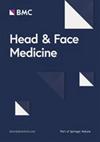头围相对大于尺寸:矢状面颅缝闭闭婴儿的一种新的筛查工具
IF 2.4
2区 医学
Q2 DENTISTRY, ORAL SURGERY & MEDICINE
引用次数: 0
摘要
微创技术治疗孤立性矢状面颅缝闭塞的疗效随着年龄的增长而下降;因此,及时转诊至关重要。我们试图确定一种筛选工具,使用来自健康儿童访问的数据。我们假设许多矢状颅缝闭合的婴儿,但根据生长图绘制的没有大头畸形,实际上有相对的大头畸形。所有具有CT和手术/病理证实的孤立矢状颅缝闭塞的婴儿都被确定。收集生长图数据(头围(HC)、体重、头冠到脚趾的长度、世界卫生组织(WHO)和疾病控制与预防中心(CDC)的百分位数和偏差(z-scores))。相对大头畸形定义为头围从大小(体重和/或长度)来看>2SD。初步试点筛选表明,世卫组织增长图表数据可作为一种筛选工具。随后的回顾性病例对照研究和曲线下面积(AUC)分析显示,HC:长度比≥0.71表明孤立性矢状颅缝闭锁年龄为1周龄,而HC:长度比≥0.67表明早在2周龄时敏感性(0.89)和特异性(1.00)最大。逻辑回归的前瞻性内部验证表明,1 ~ 2月龄时,HC:长度比具有较大的歧视性。当长度加上头围作为筛选工具时,我们可以识别早在1周开始的异常生长模式。这代表了一个设计自动警报的机会,很容易编程到电子医疗记录中,并可能提示儿科医生尽早将患者转介给颅面外科医生。本文章由计算机程序翻译,如有差异,请以英文原文为准。
Head Circumference is Relatively Larger Than Size: A Novel Screening Tool for Infants With Sagittal Craniosynostosis
The efficacy of minimally invasive techniques for addressing isolated sagittal craniosynostosis decreases with age; thus, timely referral is critical. We sought to identify a screening tool using data from well-child visits. We hypothesized that many infants with sagittal craniosynostosis, but no macrocephaly based on growth chart plotting, in fact have a relative macrocephaly. All infants with CT and surgically/pathologically confirmed isolated sagittal craniosynostosis were identified. Growth chart data was collected (head circumference (HC), weight, crown-to-toe-length, and World Health Organization (WHO) and Centers for Disease Control and Prevention (CDC) percentiles and deviation ( z-scores)). Relative macrocephaly was defined as head circumference >2SD from size (weight and/or length). Initial pilot screen indicated that WHO growth chart data has utility as a screening tool. Subsequent retrospective case-control study with area under the curve (AUC) analysis revealed that HC:length ratio ≥0.71 is indicative of isolated sagittal craniosynostosis as young as 1 week of age, while HC:length ratio ≥0.67 represents the maximization of sensitivity (0.89) and specificity (1.00) as early as 2 weeks old. Prospective internal validation with logistic regression demonstrated that at ages 1 to 2 months greater discriminatory value HC:length ratio was observed. When length is added to head circumference as a screening tool we may identify an abnormal growth pattern beginning as early as 1 week. This represents an opportunity to design an automated alert easily programed into the electronic medical records and may prompt pediatricians to refer patients to craniofacial surgeons early.
求助全文
通过发布文献求助,成功后即可免费获取论文全文。
去求助
来源期刊

Head & Face Medicine
DENTISTRY, ORAL SURGERY & MEDICINE-
CiteScore
4.70
自引率
3.30%
发文量
32
审稿时长
>12 weeks
期刊介绍:
Head & Face Medicine is a multidisciplinary open access journal that publishes basic and clinical research concerning all aspects of cranial, facial and oral conditions.
The journal covers all aspects of cranial, facial and oral diseases and their management. It has been designed as a multidisciplinary journal for clinicians and researchers involved in the diagnostic and therapeutic aspects of diseases which affect the human head and face. The journal is wide-ranging, covering the development, aetiology, epidemiology and therapy of head and face diseases to the basic science that underlies these diseases. Management of head and face diseases includes all aspects of surgical and non-surgical treatments including psychopharmacological therapies.
 求助内容:
求助内容: 应助结果提醒方式:
应助结果提醒方式:


